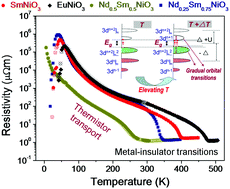Overcoming synthetic metastabilities and revealing metal-to-insulator transition & thermistor bi-functionalities for d-band correlation perovskite nickelates†
Abstract
Effective synthesis of meta-stable materials challenging the thermodynamic limits will play a significant role in broadening the horizon in material designs and further explorations of their functionalities. Although d-band correlated rare-earth nickelate perovskites (ReNiO3) have achieved promising applications, e.g., metal-to-insulator transition, artificial intelligence, and memory/logical devices, the thermodynamic instability and high vacuum-dependence in material synthesis have largely caused bottlenecks in these applications. Herein we demonstrate a vacuum-free and low cost chemical route to effectively synthesize single-crystalline ReNiO3 thin films that further promote their device applications. It achieves high flexibility and convenience by adjusting the A-site compositions within the perovskites via single (i.e. Nd, Sm, Eu, and Gd), binary (i.e., Sm1−xNdx and Sm1−xEux) and triple (i.e. Sm1−x−yNdxEuy and Sm1−x−yNdxGdy) rare-earth elements. The respective regulations in electronic structures, as probed via near edge X-ray absorption fine structure analysis, result in sharper metal-to-insulator transitions within a broad temperature range of 400 K, compared with their reported performances. Furthermore, we discover an overlooked thermistor transport behavior of ReNiO3 within the binary A-site elements, which exhibits large temperature coefficients of resistance (>2%) across a broad range of temperatures (5–470 K). By overcoming the bottlenecks in material synthesis of ReNiO3, the present work profoundly paves the way for device fabrication.



 Please wait while we load your content...
Please wait while we load your content...